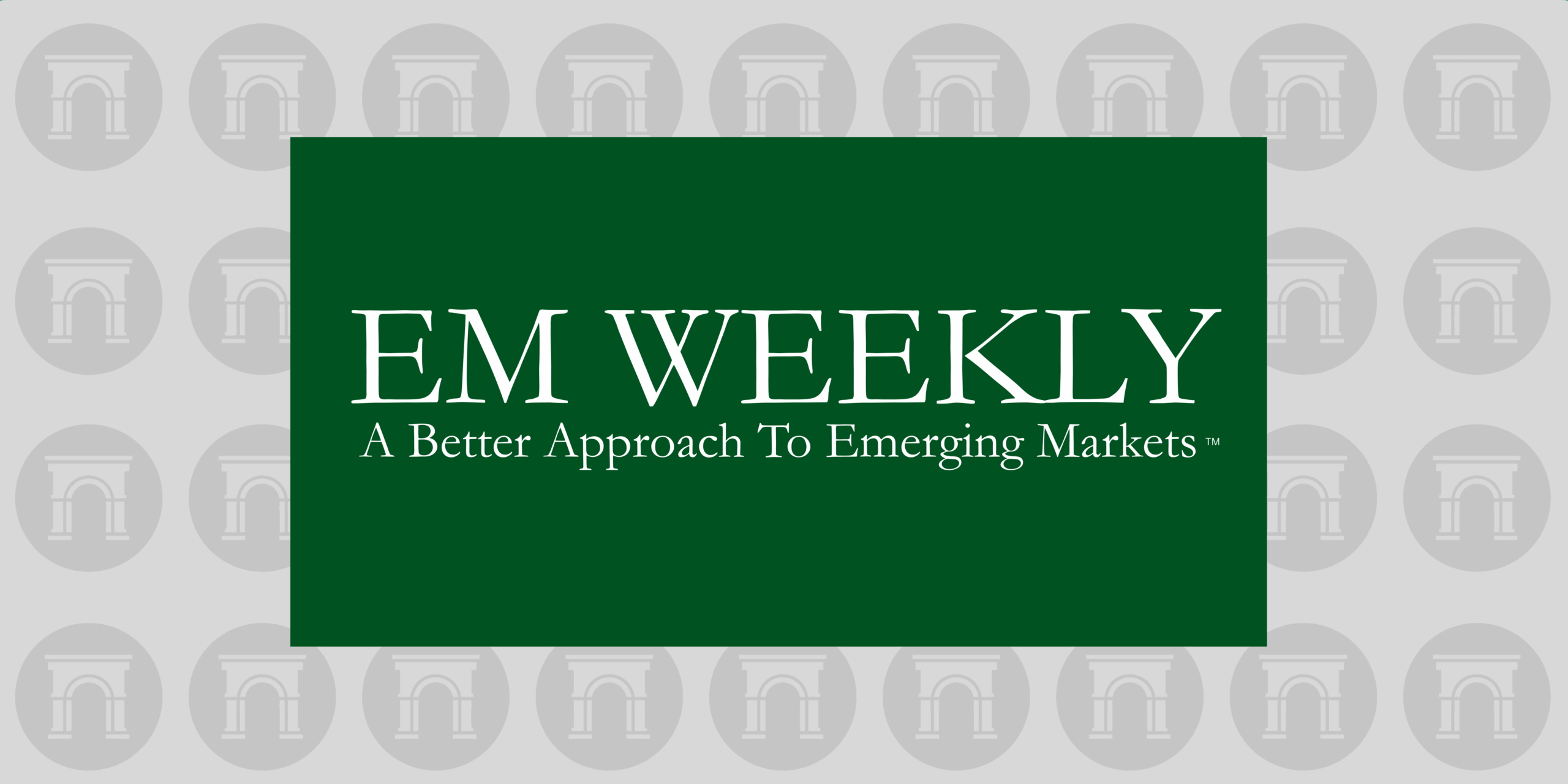Contents
Market Overview
Macro Update
This week’s benign July consumer inflation data fueled Wall Street expectations for a September rate cut. Headline CPI came in at 2.7% year-over-year, 10bps below consensus, as tariff-pass through remained more muted than feared. Later in the week, however, rate cut expectations moderated after producer price data surprised to the upside, registering at 3.3% year-over-year and 0.9% month-over-month, led by services costs. Nevertheless, most sell-side analysts have opted for only a modest upward revision to July core PCE expectations, retaining market expectations for a September cut.
Policymakers will likely remain divided over the scope and durability of tariff pass-through to inflation, as well as on a data-dependent approach versus a more strategic and forward-looking one. Adding to the overall economic picture this week, the Empire Manufacturing Survey handily beat consensus, at 11.9, while jobless claims and retail sales were largely in line with expectations. The University of Michigan survey showed whiffs of stagflation as sentiment dipped and inflation expectations rose.
The debate around future Fed leadership continued as the list of potential replacements for Chair Jerome Powell has expanded to include Jefferies’ David Zervos and Blackrock’s Rick Rieder. Meanwhile, President Donald Trump and Treasury Secretary Scott Bessent continued to reiterate their preference for lower interest rates. Newly appointed BLS chief, E.J. Antoni, signaled a potential reassessment of the labor data process, hinting at a pause in monthly jobs reports to improve estimation methodologies. However, the White House reportedly walked this back.
Despite this week’s mixed data, U.S. equity market strength endured, with the S&P 500 up 1% over the week, while the dollar moved sideways. Treasury markets ended the week slightly higher, with the 10-year yield at 4.28%, and the 30-year yield at 4.87%. Oil markets were little changed with WTI and Brent down 0.6% and 0.3%, respectively.
In the UK, the downward trend in payroll employment continued, wage growth slowed, and the unemployment rate held steady at 4.7%. Second quarter GDP moderated but beat expectations on the back of robust government spending, though business investment lagged. The implied market probability of BOE cuts declined in the aftermath. Eurozone 2Q GDP was in line with expectations, while industrial production surprised to the downside.
On the trade front, the U.S.-China truce was extended to November 10th. A White House fact sheet struck an optimistic tone, noting that “each round of negotiations with the Chinese has built on each other” and quoting President Trump as saying, “we’re getting along with China very well.” Meanwhile, South Africa readied a revised trade framework to submit to the U.S. in an effort to reduce its 30% tariff rate. This reflected room – at least at the margin – for further evolution of the current tariff regime.
In China, soft household credit, retail sales, industrial production, housing, and investment data spurred policymakers to unveil new details about interest subsidy programs for household consumer and targeted services business loans. Additionally, authorities are reportedly readying efforts to enhance utilization of funding to purchase unsold homes and reduce inventory. Elsewhere in the region, Japan 2Q GDP came in stronger than anticipated and bolstered expectations for a rate hike before year-end.
In the geopolitical arena, President Trump met with Russian President Vladimir Putin in a much-anticipated summit in Alaska. He issued a strong warning to the Russian president and threatened severe consequences if a ceasefire is not achieved in Ukraine. He also conveyed hopes for a trilateral summit with Ukrainian President Volodymyr Zelenskiy and President Putin to come out of the session.
EM Credit Update
EM hard currency sovereign debt posted a strong week, returning 1.9%, supported by a relatively calmer global risk environment. The high yield segment led performance with a 2.6% return, significantly outpacing the 1.2% return from investment grade sovereigns. Sovereign spreads narrowed by 12bps overall, driven by a 31bps tightening in high yield, while investment grade spreads were broadly stable.
Ecuador stood out as the top performer, rallying 29.9% as markets responded positively to President Noboa’s re-election and policy continuity. In contrast, Bolivia underperformed, losing 1.5% amid growing concerns over foreign exchange pressures and the use of capital controls, both weighing on investor confidence.
EM corporates lagged sovereigns this week, delivering a more modest 0.9% return. The performance was relatively uniform across credit quality, but spreads widened by 8bps.
EM local currency sovereigns returned 1.0%, supported by a broad-based foreign exchange recovery and continued softness in the U.S. dollar. South Africa and Mexico led gains, benefiting from renewed foreign inflows and improved macro sentiment. Türkiye, however, underperformed with a 1.2% loss.
Primary market activity resumed this week with Colombia issuing $3.8 billion and 13 corporate issuers tapping the market.
The Week Ahead
All eyes will be on Washington next week as the IMF publishes its latest World Economic Outlook alongside the Spring Meetings, where investors, policymakers, and economists will convene against a backdrop of heightened geopolitical and economic uncertainty.
In the U.S., attention will remain divided between corporate earnings and a series of key economic data releases, including regional Fed surveys from Richmond and Kansas City, S&P Global Manufacturing PMIs, new home sales, and the University of Michigan consumer sentiment index.
In the eurozone, the focus will be on flash PMI data and consumer confidence, with particular interest in the German IFO business climate survey as markets assess the potential impact of ongoing trade tensions and tariff uncertainty on the bloc’s largest economy.
The UK will release retail sales and PMI data, which will be closely scrutinized for signs of how domestic consumption and business activity are evolving.
In Asia, attention will turn to monetary policy decisions from the People’s Bank of China and Bank Indonesia.
Fixed Income
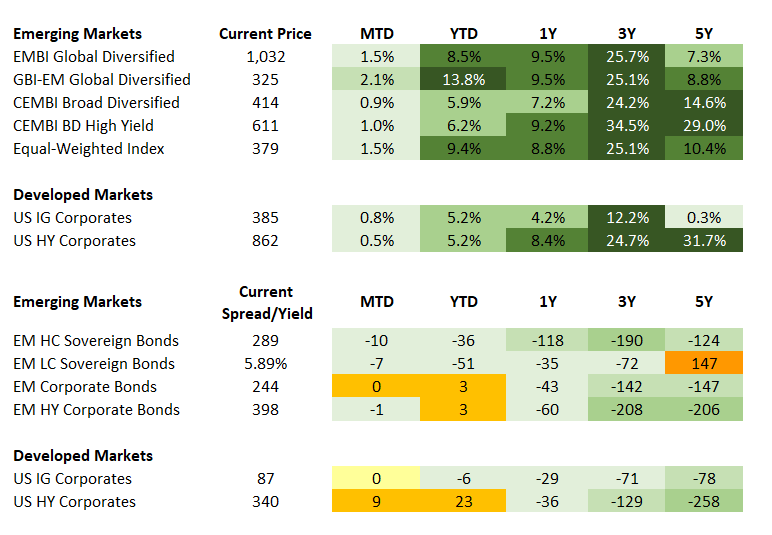
Equities
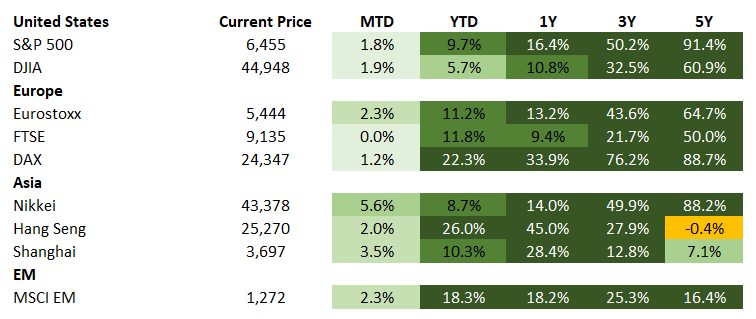
Commodities

Source for data tables: Bloomberg, JPMorgan, Gramercy. EM Fixed Income is represented by the following JPMorgan Indicies: EMBI Global, GBI-EM Global Diversified, CEMBI Broad Diversified and CEMBI Broad High Yield. DM Fixed Income is represented by the JPMorgan JULI Total Return Index and Domestic High Yield Index. Fixed Income, Equity and Commodity data is as of August 15, 2025 (mid-day).
Country Highlights
India Receives Rating Upgrade Despite Tariff Headwinds
Event: S&P lifted India’s ratings by one-notch to BBB and revised the outlook to stable from positive. The action is underpinned by robust economic growth, prioritization of fiscal consolidation, and enhanced monetary policy with inflation targeting that has anchored inflation expectations. Moody’s and Fitch rate India at Baa3 and BBB-, respectively, with stable outlooks.
Gramercy Comment: The rating move is constructive for sovereign and corporate credit and underscores the view that higher U.S. tariffs on imports from India should not threaten India’s medium-term growth prospects or credit profile. As highlighted last week, India’s large and consumption-driven economy helps to mitigate the overall drag from lower trade with the U.S. The July CPI data released this week continued to show softening, to 1.55% year-over-year from 2.10% year-over-year the prior month, underscoring the enhancements to the country’s monetary policy framework.
Pakistan Obtains Another Rating Upgrade
Event: Moody’s lifted Pakistan’s ratings one notch to Caa1 with a stable outlook on the back of the country’s improved external position and reform execution under its IMF Extended Fund Facility (EFF) and recently approved Resilience and Sustainability Facility. The move followed earlier upgrades from Fitch and S&P to B- with stable outlooks.
Gramercy Comment: We see the upgrade as a positive development, although it had been priced and anticipated by markets. It is reflective of the authorities’ improved ability and willingness to pursue macroeconomic adjustment and bolster the country’s still low foreign exchange reserve buffers.
Looking ahead, we expect a smooth upcoming September IMF review and $1 billion disbursement, given solid headline fiscal performance and budget commitments, tight monetary policy, and an incrementally more flexible rupee. This is notwithstanding potential slippage on select targets. The authorities will need to remain vigilant on fiscal consolidation, greater foreign exchange flexibility, and structural reforms.
Emerging Markets Technicals
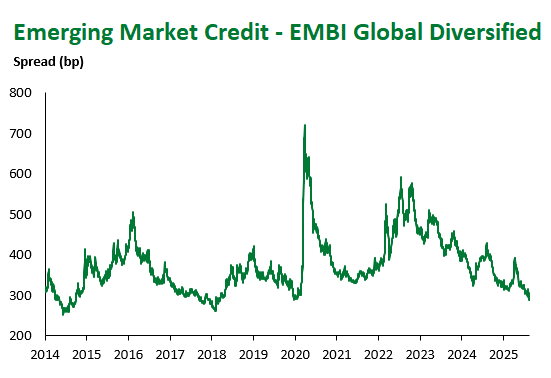
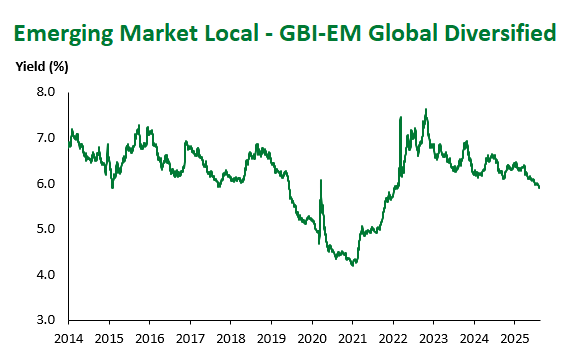
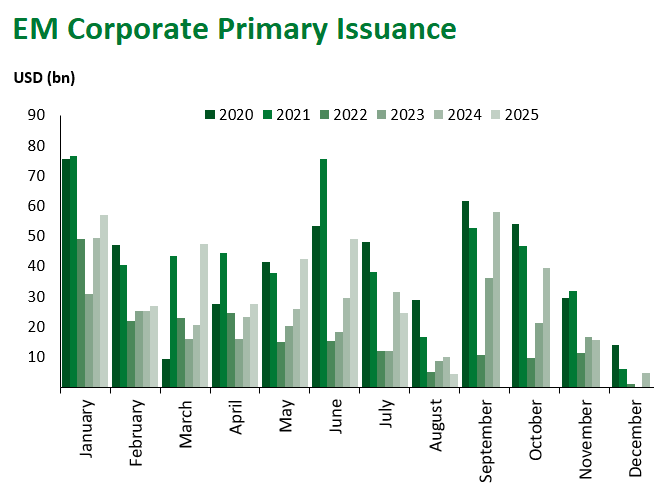
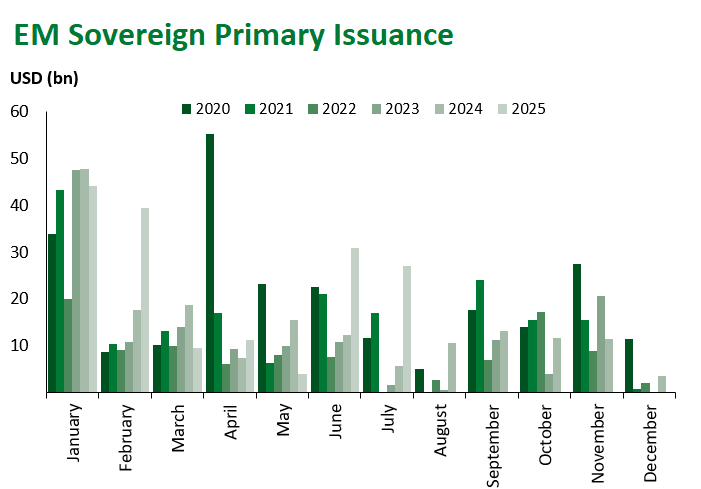
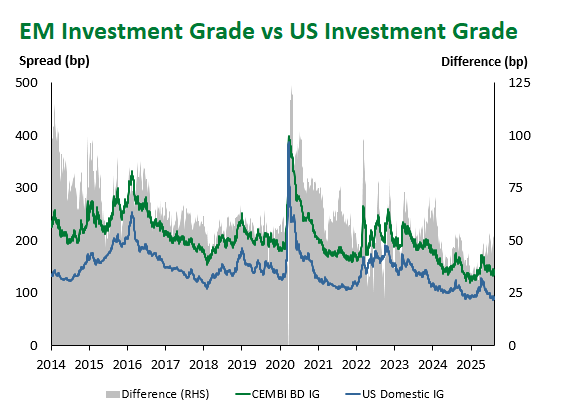

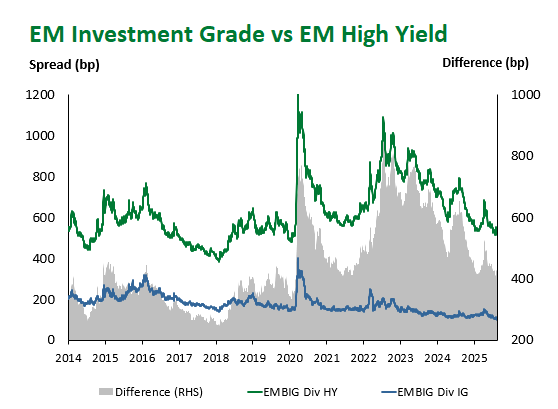
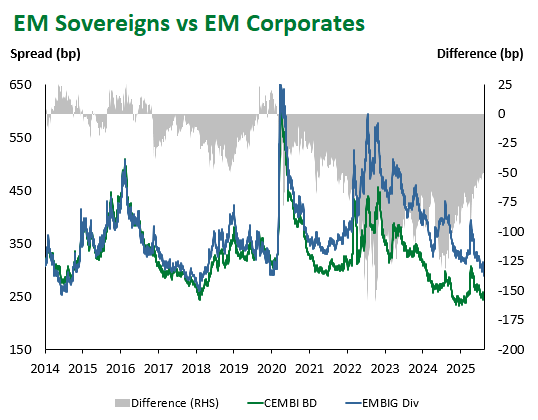
Emerging Markets Flows


Source for graphs: Bloomberg, JPMorgan, Gramercy. As of August 15, 2025.
For questions, please contact:
Kathryn Exum, CFA ESG, Director, Co-Head of Sovereign Research, [email protected]
Petar Atanasov, Director, Co-Head of Sovereign Research, [email protected]
This document is for informational purposes only. The information presented is not intended to be relied upon as a forecast, research or investment advice, and is not a recommendation, offer or solicitation to buy or sell any securities or to adopt any investment strategy. Gramercy may have current investment positions in the securities or sovereigns mentioned above. The information and opinions contained in this paper are as of the date of initial publication, derived from proprietary and nonproprietary sources deemed by Gramercy to be reliable, are not necessarily all-inclusive and are not guaranteed as to accuracy. This paper may contain “forward-looking” information that is not purely historical in nature. Such information may include, among other things, projections and forecasts. There is no guarantee that any forecasts made will come to pass. Reliance upon information in this paper is at the sole discretion of the reader. You should not rely on this presentation as the basis upon which to make an investment decision. Investment involves risk. There can be no assurance that investment objectives will be achieved. Investors must be prepared to bear the risk of a total loss of their investment. These risks are often heightened for investments in emerging/developing markets or smaller capital markets. International investing involves risks, including risks related to foreign currency, limited liquidity, less government regulation, and the possibility of substantial volatility due to adverse political, economic or other developments. References to any indices are for informational and general comparative purposes only. The performance data of various indices mentioned in this update are updated and released on a periodic basis before finalization. The performance data of various indices presented herein was current as of the date of the presentation. Please refer to data returns of the separate indices if you desire additional or updated information. Indices are unmanaged, and their performance results do not reflect the impact of fees, expenses, or taxes that may be incurred through an investment with Gramercy. Returns for indices assume dividend reinvestment. An investment cannot be made directly in an index. Accordingly, comparing results shown to those of such indices may be of limited use. The information provided herein is neither tax nor legal advice. Investors should speak to their tax professional for specific information regarding their tax situation.
